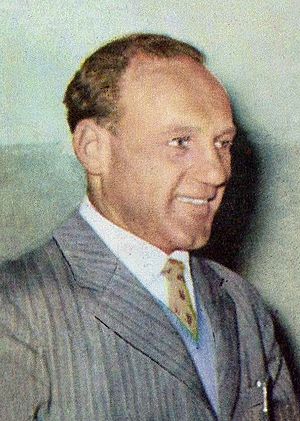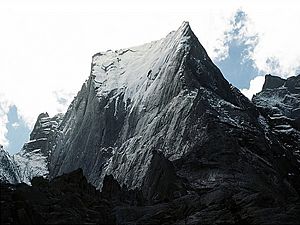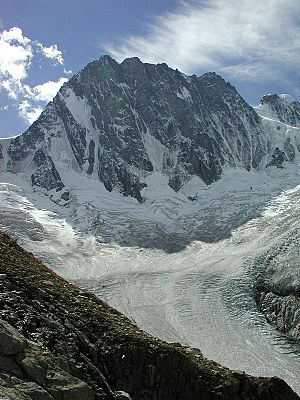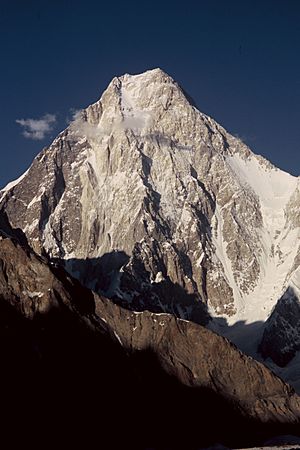Riccardo Cassin facts for kids
Riccardo Cassin (born January 2, 1909 – died August 6, 2009) was a famous Italian mountain climber. He was also a talented designer of climbing gear and an author. Riccardo Cassin played a huge role in the history of rock climbing, alpine climbing (climbing high mountains), and big wall climbing (climbing very tall, steep rock faces).
Contents
Early Life and Dreams
Riccardo Cassin was born on January 2, 1909, in a small town called San Vito al Tagliamento, Italy. His family was not wealthy. When he was just three years old, his father, Valentino, moved to Canada for work. Sadly, his father died in a mining accident in 1913.
Riccardo had to leave school at age 12 to start working for a blacksmith. At 17, in 1926, he moved to Lecco, a city in Italy, and found a job at a steel factory. At first, he loved boxing. But soon, he became fascinated by the tall mountains around Lake Como and Lake Garda. These mountains inspired him to start climbing.
In 1940, Riccardo married Irma. They had three sons together: Valentino, Pierantonio, and Guido.
Amazing Mountain Climbs
Riccardo Cassin started mountain climbing around 1930. He joined a group of climbers known as the Ragni di Lecco, which means "Spiders of Lecco."
He achieved many first ascents, meaning he was the first person to climb a certain route. In 1934, he made the first climb of the Piccolissima of the Tre Cime di Lavaredo. In 1935, he climbed a new route on the north face of Cima Ovest di Lavaredo with Vittorio Ratti.
One of his most famous climbs was in 1937 on the north-east face of Piz Badile in Switzerland. This was a challenging three-day climb from July 14–16. He climbed with Vittorio Ratti and Gino Esposito. Two other climbers, M. Molteni and G. Valsecchi, joined them but sadly died on the way down. This route is now known as the Cassin Route. Fifty years later, at age 78, Riccardo climbed this route again, showing his incredible skill!
Perhaps his most celebrated first ascent was the Walker Spur. This is a part of the north face of the Grandes Jorasses in the Mont Blanc massif. He completed this climb from August 4–6, 1938, with Esposito and Ugo Tizzoni. Experts called this climb "the finest alpine challenge."
In 1939, Cassin and Tizzoni made another first ascent. They climbed a very steep line on the north face of the Aiguille de Leschaux.
Riccardo Cassin was one of the best climbers between World War I and World War II. He made a total of 2,500 climbs, and more than 100 of these were first ascents!
World War II
During World War II, Riccardo Cassin fought with the partisans. These were groups who fought against the German forces occupying Italy. In April 1945, Cassin was a partisan leader. He and Vittorio Ratti tried to stop some German soldiers from escaping. Sadly, Ratti was shot and died. Cassin was honored for his brave actions during the war from 1943 to 1945.
Leading Expeditions
Riccardo Cassin was supposed to be part of the Italian expedition to K2 in 1954. This expedition made the first ascent of K2, one of the world's highest mountains. However, the main leader, Ardito Desio, did not want Cassin to join. Cassin believed Desio felt threatened by his experience.
After this, Cassin focused on organizing and leading his own expeditions. In 1958, he led an expedition where Walter Bonatti and Carlo Mauri made the first ascent of Gasherbrum IV in the Karakoram Range. In 1969, he led another expedition that climbed Jirishanca in the Andes mountains.
In 1961, Cassin led an expedition to Mount McKinley (now Denali) in Alaska. He also successfully climbed it himself! They made the first ascent of the "Cassin Ridge," which was the most challenging route on the mountain at that time. After this amazing climb, President John F. Kennedy sent Cassin a telegram to congratulate him.
In 1975, Cassin led an expedition to the south face of Lhotse in the Himalaya. This part of the mountain had never been climbed before. However, they faced bad weather and could not complete the climb.
Inventing Climbing Gear
In 1947, Riccardo Cassin started his own company in Lecco, Italy. He began designing and making mountaineering equipment. His first products were rock pitons, which are metal spikes used to help climbers.
Over the next few years, he created more important climbing tools:
- 1948: His first hammers for climbing.
- 1949: His first ice axes.
- 1950: His first carabiners (metal loops used to connect ropes and gear).
- 1950: He also made the first warm down jackets for expeditions to very cold places. These jackets went into full production two years later.
- 1958: He and his son created their first climbing harness. This harness started being produced two years later.
- 1960: He introduced crampons made of titanium, a very strong and light metal.
In 1967, his company became a Limited Company. In the early 1980s, the company moved to Valmadrera. In 1997, another company called CAMP bought the Cassin brand.
A Century of Adventure
Riccardo Cassin's 100th birthday was on January 2, 2009. To celebrate, a special book was created called Riccardo Cassin: Cento volti di un grande alpinista (which means "Riccardo Cassin: One Hundred Faces of a Great Alpinist"). This book contained 100 stories and tributes from people who knew Cassin, including famous climbers and even President John F. Kennedy.
Riccardo Cassin passed away in Piano dei Resinelli, Lecco, on August 6, 2009. He was 100 years old.
Honours
- Cavaliere di Gran Croce Ordine al merito della Repubblica Italiana (Rome, 9 February 1999)
- Grand'Ufficiale dell'Ordine al merito della Repubblica Italiana (5 January 1980)
See also
 In Spanish: Riccardo Cassin para niños
In Spanish: Riccardo Cassin para niños






